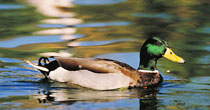Natural Reflections
What's Happening to Our Boreal Forest and Its Birds?
by
Donald Sutherland, PAg

Most of us get very excited when we notice songbirds of many sizes, colours, and sounds in our yards, on windowsills, on roadsides, and in fields. There is something innocent, mysterious, and spiritual about them. They remind me of angels. We see most of them in spring and fall as seasonal visitors on their annual migration route. Those that spend the winter here enjoy our bird feeders and we enjoy them as loyal friends. Most of them spend their winters in Mexico, Central and South America, and the West Indies.
Summer is nesting time, brood time and, most importantly, insect-eating time. Without insects songbirds quickly starve, and, of course, vanish to join the many species of animals and plants that our industrial world has already extinguished. The last great insect factory, and, therefore, songbird hatchery in the world is Canada's boreal forest. From east to west it stretches from Newfoundland to the Yukon, and from north to south from the arctic tundra to Prince Albert. The boreal forest was named after the Greek god of the north wind, Boreal.
In the September-October 2005 issue of Audubon, Keith Hobson, research scientist for the Canadian Wildlife Service, has drawn our attention to this great Canadian and world heritage that is now in grave danger. Some 3 billion songbirds nest in Canada's boreal each summer producing an astounding migration south, each fall, of approximately 5 billion beautiful birds. Is there nowhere else in the world to nest? Hobson points out that the other major boreal forests such as Scandinavia, northern United States, and eastern Canada are largely gone.
Hobson warns us that less than 10 percent of our boreal forest is protected. All of Canada's provinces have stated their intention to accelerate resource extraction in the next ten years. Thirty percent of the standing forest has already been allocated to industrial extractors such as logging, oil and gas, and mining interests; an additional 30 percent is subject to current or proposed land-use planning procedures. Global Forest Watch has compiled Satellite maps of our northern boreal showing 40 percent of it no longer intact due to roads, seismic lines, mine-sites, and logging.
The advocacy group Forest Ethics reports that about half of the paper used to print magazines, newsprint, and the 17 billion catalogues produced annually in the United States was once bird habitat. Disposable paper products like Charmin, Puffs, Kleenex, and Bounty use more than 2.5 million tons of pulp annually, mostly from trees sawn in the boreal. Canada's boreal forests are razed at a rate of about 5 acres per minute to feed the voracious consumption of wood and wood products of the United States alone.
What can you and I do? Cancel our catalogue subscriptions and order on-line; refuse flyers; buy only recycled tissue and printing paper; email our politicians; buy and promote alternative fibres such as hemp and flax straw. Lastly, become informed by using the following web sites:
www.audubon.org/campaign/boreal.html
www.conservatree.com/paper/PaperGuide/Tissue/consumer.bath.shtml
www.borealcanada.ca
Reprinted courtesy of Earthcare Connections, PO Box 2800, Humboldt, SK S0K 2A0. Phone (306) 682-2407, fax (306) 682-5416, email: earthcare@sasktel.net, www.earthcare.sk.ca. Donald Sutherland is a career counsellor, personal coach, and mediator with special training in restorative justice. He is also a professional agrologist and active farmer, email: donaldsutherland@sasktel.net. |
